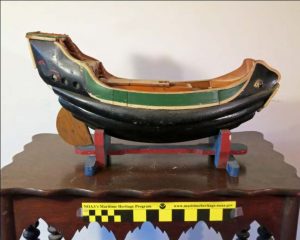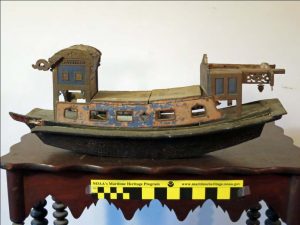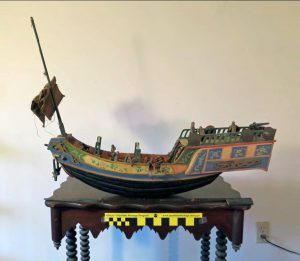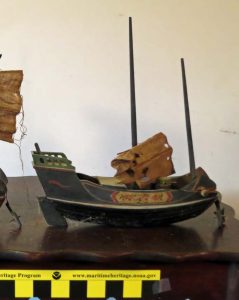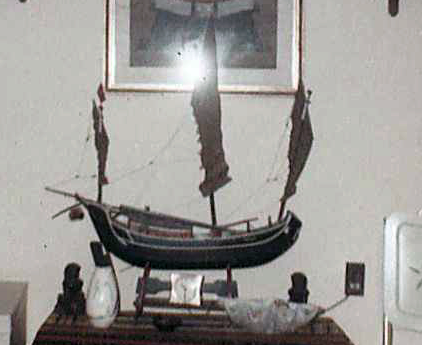Wells Collection
Hans van Tilburg (2012) NOAA report:
During his several tours of duty in East Asia (1922-1932), Lieutenant Forrest H Wells USN became fascinated with Chinese sailing craft. Subsequently, he took thousands of photographs of Chinese sailing junks, and collected numerous (43) wooden models from shipwrights and other sources. Later in his life he wrote several scholarly articles on the subject and came to be regarded as a prominent US expert in Chinese nautical historical development. Following his death, his rare model collection passed to his daughter, Ms. Kathryn Mears. It has since been boxed, moved, unboxed, and (no longer actively maintained) is beginning to fall into disrepair. Many of the vessels are extremely detailed and accurate representations and contain a wealth of technical and cultural information. Most of these models were intended for shipwrights in lieu of (non-existent) plans for the construction of a wide variety of traditional working Chinese junks. Large working models typically served this historically critical role in many seafaring cultures across the world. Most if not all of these traditional Chinese working craft no longer exist, and few were documented in any systematic fashion. These are glimpses of a vanished past.

In 2009 Ms. Mears contacted Dr. Hans Van Tilburg (having read his book/dissertation on Chinese ship design and seafaring history Chinese Junks on the Pacific: Views from a Different Deck 2007) and gave the photo collection and all of FH Wells’ research notes to him for preservation, interpretation, and ultimately the benefit of the scholarly community. Furthermore, Ms. Mears requested assistance in finding a home for the large model collection. The Smithsonian Museum had, years earlier, expressed interest in this collection…provided that Ms. Mears package, insure, and transport the collection to the museum, and provide support for its display and curation (an impractical expectation). Van Tilburg works for NOAA’s Maritime Heritage Program, which promotes efforts to preserve our world maritime heritage, and is supportive of assisting with this unique model collection. The goal of this specific project is to locate a proper long-term institutional home for the significant models among the collection below and assure the reconstruction, maintenance and display of these rare items.
In late September 2012 Van Tilburg traveled to Columbia MO, and with the kind assistance of Ms. Mears completed a preliminary photo survey of the model collection (September 26). No attempt was made to reassemble any of the models; they were photographed “as is”. Many of the disassembled parts and sails still exist and were also recorded (some associated with specific models, some not). These images have now been matched to FH Wells’ own inventory list (“Wells Collections of Oriental Ship Models”), which includes his brief notes on each model, and descriptive code (group letter category, number of masts and length, main decorative features), as well as the latitude and sometimes longitude of the original “home” of the junks, or year of collection.
The Wells Collection at Texas A&M
The Lieutenant Wells collection of Asian models was donated to Texas A&M University in 2014 and is housed in the Center for Maritime Archaeology and Conservation (CMAC), where the models are undergoing cleaning and conservation care.

The collection encompasses 44 models of various provenances, sizes and quality. We hope to be able to study and publish each one of these vessels.
At this time we are inventorying, photographing, and matching each model wit the papers that came with the collection and the careful inventory made by Dr. Hans van Tilburg, including the pictures.
Below is a table with the model numbers, one or two pictures, and the model designation in Lt. Wells undated inventory. Among the papers that came with the collection of models there are old pictures showing the models in his residences through time. At this stage of our project, we have not identified all the models. We hope to update this table regularly in the incoming months.
Lieutenant Wells inventory has some codes, which mean the following: The first set of code consists of one or two letters and two numbers, separated by a dash. These letters and numbers have the following meanings: W – Rudders suspended from a windlass; R – Removable rudders; FA – Fixed rudders abaft the stock; FB – Fixed rudders balanced by a fin forward of the stock; N – No rudder; and NO – No rudder with outrigger. The first number indicates the number of mast. It is followed by a dash and the length in inches. The second set of codes consists of two or three letters between brackets: v – varnished; b – painted black; o – oculus on the bow; g – bulworks painted in geometric areas of solid color; r – painted russet brown; k – presence of pa-kua; c- painted crimson red.












